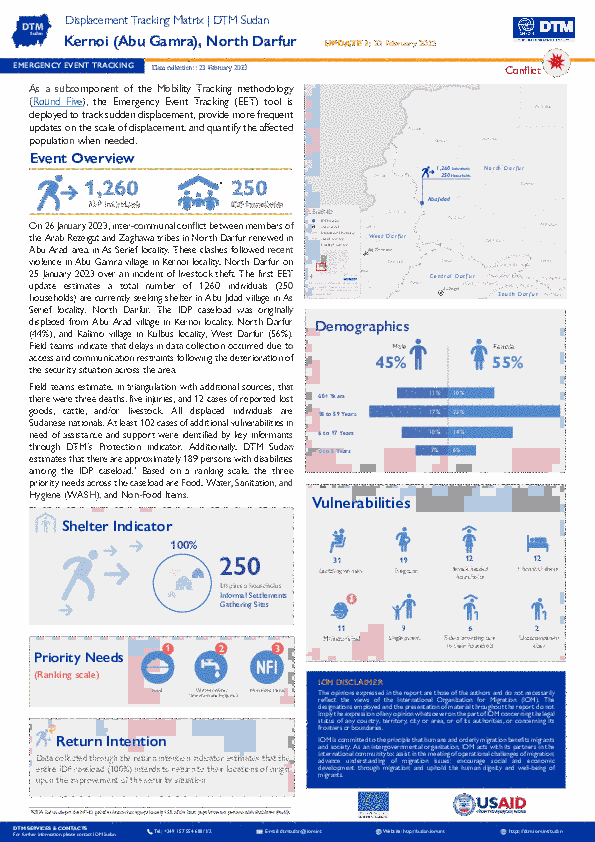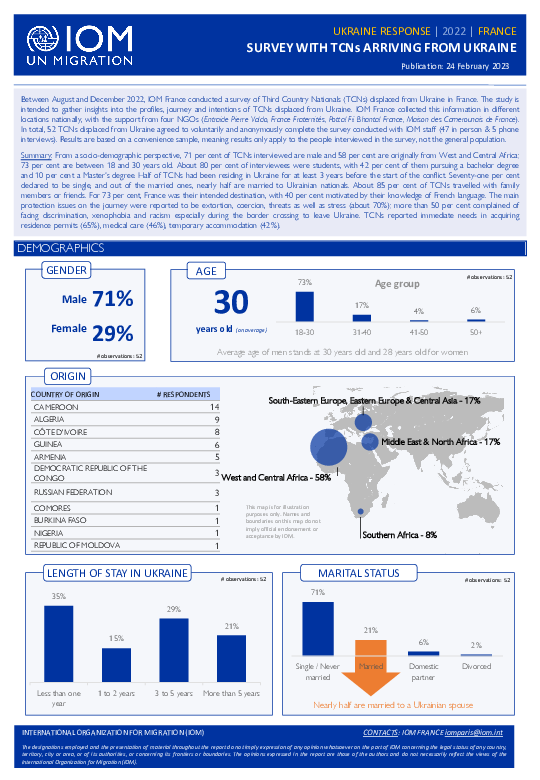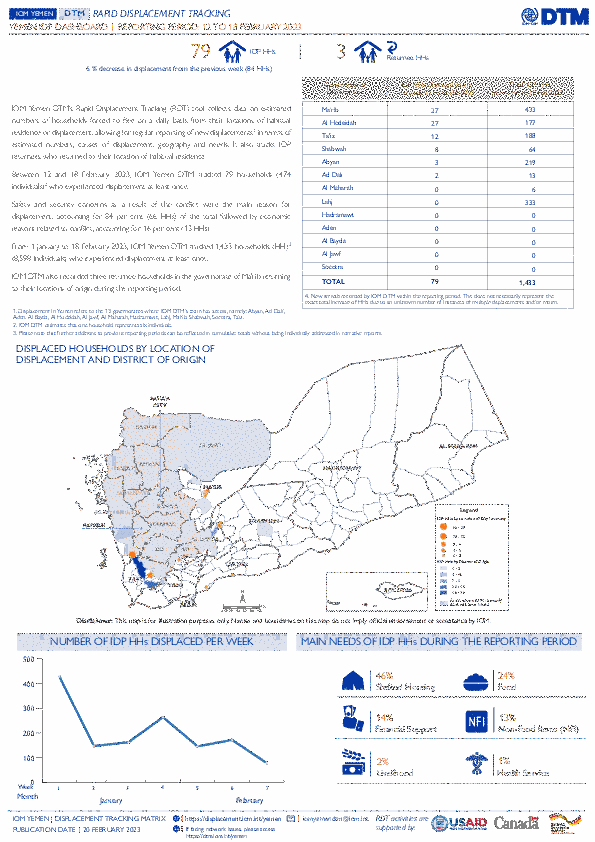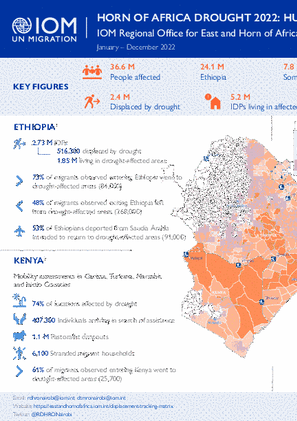-
Countries
-
Data and Analysis
-
Special Focus
-
Crisis Responses

Contact
DTM Sudan; dtmsudan@iom.int
Language
English
Location
Sudan
Snapshot Date
Feb 23 2023
Activity
- Mobility Tracking
- Event Tracking
The DTM Emergency Event Tracking (EET) is deployed to track sudden displacement and population movements, provide more frequent updates on the scale of displacement, and quantify the affected population when needed. As a subcomponent of the new Mobility Tracking methodology in Sudan (Round Five), and activated on a need basis, EET utilises a broad network of key informants to capture best estimates of the affected population presence per location – a useful tool for humanitarian response planning and design.

Contact
iomparis@iom.int
Language
English
Location
France
Period Covered
Aug 01 2022
Dec 31 2022
Activity
- Survey
Between August and December 2022, IOM France conducted a survey of Third Country Nationals (TCNs) displaced from Ukraine in France. The study is intended to gather insights into the profiles, journey and intentions of TCNs displaced from Ukraine. IOM France collected this information in different locations nationally, with the support from four NGOs (Entraide Pierre Valdo, France Fraternités, Pottal Fii Bhantal France, Maison des Camerounais en France). In total, 52 TCNs displaced from Ukraine agreed to voluntarily and anonymously complete the survey conducted with IOM staff (48 interviews in person and 5 by phone).

Contact
DTM Uganda, dtmuganda@iom.int
Language
English
Location
Uganda
Period Covered
Jan 01 2023
Jan 31 2023
Activity
- Mobility Tracking
In January 2023, three districts were reported to be hit by disasters. Floods were reported in Kampala while Kanungu was ravaged by heavy storms and wildfires in Kotido.
So far, a total of 1,540 individuals were affected by disasters, representing 257 households of which 279 individuals from 20 households were internally displaced. Over 40 houses were completely destroyed and over 10 water facilities were affected. Furthermore ,the impacts of disasters affected 24 people with disabilities, injured 11, and 7 individuals were hospitalized
Adults (19-64) were the most affected population group (49%), followed by children under 18 (28%) and the elderly above 64 (23%). And the most pressing needs are food assistance, livelihood, nutrition, health, NFIs, among others.
There were no other major disaster events reported from other districts as the infographic sheet only presents information received from represented districts.
This snapshot provides an overview of the impact of drought on human mobility in the region, with a focus on Djibouti, Ethiopia, Kenya and Somalia. In 2022, an estimated 2.4 million people were displaced by drought, 5.2 million were living in drought-affected areas, and 534,000 migrants were moving to and from such areas.

Contact
DTM Chad, dtmtchad@iom.int
Language
French
Location
Chad
Period Covered
Jan 30 2023
Feb 20 2023
Activity
- Mobility Tracking
- Event Tracking
Ce tableau de bord présente des informations sur des mouvements qui ont eu lieu le 30 Janvier, le 19 et le 20 Février 2023 dans les villes de Faya et Ounianga-Kébir, situées dans les provinces de Borkou et de l'Ennedi-Ouest, près de la frontière libyenne. Durant la période du 30 janvier au 20 février 2023, au total 217 ressortissants tchadiens et 2 ressortissantes nigérianes ont été expulsés collectivement de la Libye et sont arrivés en trois vagues dans les villes de Faya et d’Ounianga - Kébir. Parmi ces personnes, 45 ressortissants tchadiens sont arrivés à Faya le 30 janvier 2023 ; 106 ressortissants tchadiens (parmi eux 17 sont des mineurs) et 2 ressortissantes nigérianes sont arrivés à Ounianga-kébir le 19 février ; et 66 ressortissants tchadiens sont arrivés à Ounianga-Kébir le 20 février 2023.

Contact
DTM Chad, dtmtchad@iom.int
Language
English
Location
Chad
Period Covered
Jan 30 2023
Feb 20 2023
Activity
- Mobility Tracking
- Event Tracking
This dashboard presents information on a movement which occurred on 30 January, 19 and 20 February 2023 in the towns of Faya and Ounianga-Kébir, located in the provinces of Borkou and Ennedi-Ouest, near the Libyan border.During the period from 30 January to 20 February 2023, a total of 217 Chadian and 2 Nigerian nationals were collectively expelled to Libya and arrived in three waves in the towns of Faya and Ounianga-Kébir. Among these individuals, 45 Chadian nationals arrived in Faya on 30 January 2023; 106 Chadian nationals (17 among them are minors) and 2 Nigerian female nationals arrived in Ounianga-Kébir on 19 February and 66 Chadian nationals arrived in Ounianga-Kébir on 20 February 2023.
Contact
DTM Yemen, iomyemendtm@iom.int
Location
Yemen
Activity
- Mobility Tracking
- Event Tracking
Period Covered
Feb 12 2023 -Feb 18 2023
From 1 January to 18 February 2023, IOM Yemen DTM tracked 1,433 households (HH) (8,598 Individuals) who experienced displacement at least once.
Between 12 and 18 February 2023, IOM Yemen DTM tracked 79 households (474 individuals) displaced at least once. The majority of people moved into/within the following governorates and districts:
- Al Hodeidah (27 HHs) – Hays (27 HHs) district. All displacements in the governorate originated from Ta’iz.
- Ma’rib (27 HHs) –Ma’rib City (22 HHs), Ma’rib (5 HHs) districts. Most displacements in the governorate originated from Al Jawf and Al Hodeidah.
- Ta’iz (12 HHs) – Al Maafer (12 HHs) district. Most displacements in the governorate were internal.
- Ta’iz (42 HHs) – Maqbanah (27 HHs), Ash Shamayatayn (11 HHs), Sabir Al Mawadim (2 HHs) districts.
- Al Bayda (11 HHs) – Nati (8 HHs), Al Quraishyah (2 HHs), As Sawadiyah (1 HHs) districts.
- Al Hodeidah (8 HHs) – Bayt Al Faqih (4 HHs), Ad Durayhimi (1 HHs), Ad Dohi (1 HHs) districts.
Population Groups
Survey Methodology
Unit of Analysis Or Observation
Type of Survey or Assessment
Keywords
Geographical Scope
Administrative boundaries with available data
The current dataset covers the following administrative boundaries

Contact
DTM Yemen, iomyemendtm@iom.int
Language
English
Location
Yemen
Period Covered
Feb 12 2023
Feb 18 2023
Activity
- Mobility Tracking
IOM Yemen DTM’s Rapid Displacement Tracking (RDT) tool collects data on estimated numbers of households forced to flee on a daily basis from their locations of origin or displacement, allowing for regular reporting of new displacements in terms of estimated numbers, geography, and needs. It also tracks returnees who returned to their location of origin.
From 1 January to 18 February 2023, IOM Yemen DTM tracked 1,433 households (HH) (8,598 Individuals) who experienced displacement at least once.
Between 12 and 18 February 2023, IOM Yemen DTM tracked 79 households (474 individuals) displaced at least once. The majority of people moved into/within the following governorates and districts:
- Al Hodeidah (27 HHs) – Hays (27 HHs) district. All displacements in the governorate originated from Ta’iz.
- Ma’rib (27 HHs) –Ma’rib City (22 HHs), Ma’rib (5 HHs) districts. Most displacements in the governorate originated from Al Jawf and Al Hodeidah.
- Ta’iz (12 HHs) – Al Maafer (12 HHs) district. Most displacements in the governorate were internal.
The majority of people moved from the following governorates and districts:
- Ta’iz (42 HHs) – Maqbanah (27 HHs), Ash Shamayatayn (11 HHs), Sabir Al Mawadim (2 HHs) districts.
- Al Bayda (11 HHs) – Nati (8 HHs), Al Quraishyah (2 HHs), As Sawadiyah (1 HHs) districts.
- Al Hodeidah (8 HHs) – Bayt Al Faqih (4 HHs), Ad Durayhimi (1 HHs), Ad Dohi (1 HHs) districts.
Monthly Overview of:
- Arrivals in the Western Balkans
- Top three nationalities at arrivals in the reporting month
- Migrants presence in reception facilities
- Migrants presence outside reception facilities
- Ukrainian nationals in the Western Balkans
- Returns and reintegration

Contact
DTMUkraine@iom.int
Language
Ukrainian
Location
Ukraine
Period Covered
Jan 01 2023
Jan 31 2023
Activity
- Mobility Tracking
- Baseline Assessment
Базова оцінка території зареєстрованих ВПО надає детальні дані щодо кількості та географічного розташування офіційно зареєстрованих внутрішньо переміщених осіб (ВПО). Збір даних для 20-го туру базової оцінки території відбувався з 1 по 31 Січня 2023 року в 23 областях та місті Києві. У охоплених областях кількість зареєстрованих ВПО була зібрана для всіх 107 районів і 967 громад (67% усіх громад в охоплених областях). Крім того, 47% громад надали дані щодо кількості ВПО із гендерною розбивкою.


